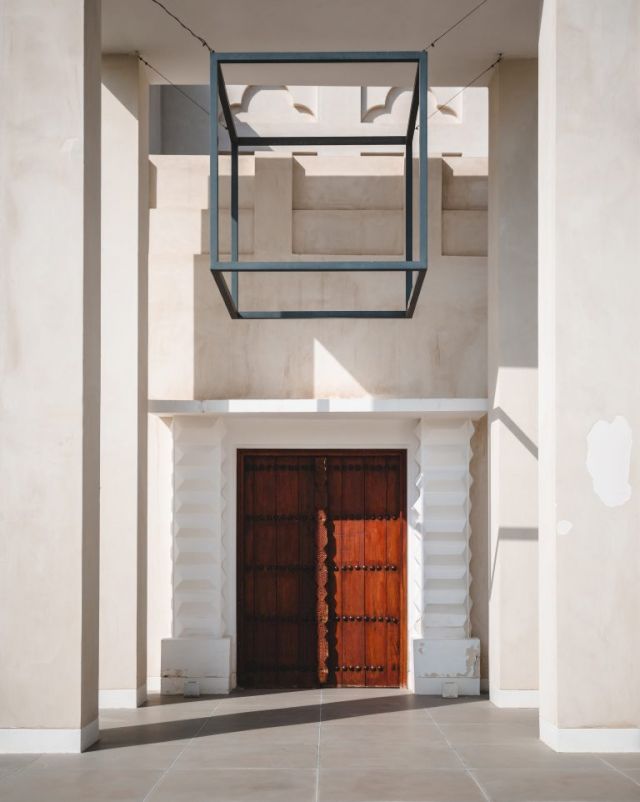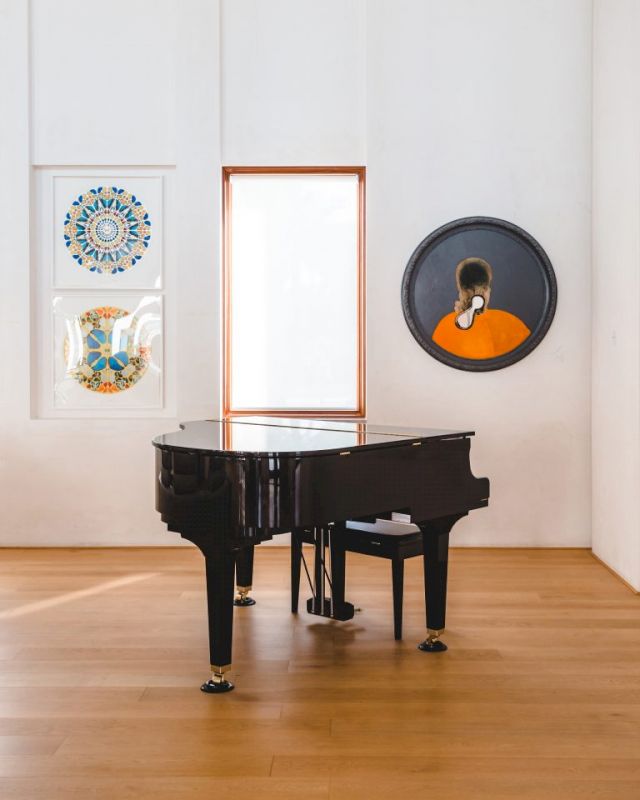Independent Collectors
Artist As Collector – Rashid Al Khalifa
An interview surrounding IC’s exploration, ‘Artist As Collector’ with Bahrain based Rashid Al Khalifa.

As IC explores ‘Artist As Collector’, meet Riffa-based Rashid Al Khalifa, who pursued art over the Police Academy, and from a young age at that.
In this interview, IC’s Curator Georgie Pope sat down with Rashid Al Khalifa at the me Collectors Room, capturing some moments for discussion, before the reception for his current Berlin participation in “Transverse Wave“, to talk about the relationship between his art-making and collecting, and how things are done in the Middle East.


IC
I’d like to start with your instigating moment to visual art. You created an abstract and I must say, already mature wall painting at around fourteen years old. At what age exactly did you consciously begin to make art and how was it that art started to become so important to you?
RASHID AL KHALIFA
I was encouraged by my family to start with, my eldest brother, who was very into art at school. The mural that you just talked about, I was about sixteen and my mother didn’t like it because I was making her wall dirty. I was using the room next to that wall with my brother, where everyday, I was seeing this empty wall and I thought, I need something to do. So I painted a mural onto it.
My school was also a great entry to art and my teacher encouraged me a lot. So when you have somebody at home and somebody at school encouraging you, then you keep on, until you don’t stop. So that’s how it started at a very early age.
After school, I got a scholarship, but the funny story is, that that scholarship was actually to go to the Police Academy, out of all my choices… So I went to the UK and of course before that, you need to do English school, to learn the language. While I was learning english, the timing was from 9am to 1pm and from 2pm until 4pm. In the town I saw a sign for evening art classes, so I registered for a course to study from 6pm until 8pm. When I finished the course in drawing and painting, the headmaster said to me “I think you should start full time”, and I said “really?”. She said “yes, you should, you are good”, and she encouraged me. I guess I didn’t need much more encouragement, so I changed my plans for the Police Academy and enrolled at Hastings College.
IC
How do you identify or position yourself today? More as an artist or as a collector?
RASHID AL KHALIFA
As an artist, definitely. I don’t emphasise collector as much, because my collection is number one for encouraging young artists and that itself largely comes from a place of being an artist. Number two, I have some works that are a great pleasure to be able to see everyday and can change a space, and I like them for that purpose because I do a lot of interiors. So collecting is not to buy and then sell the pieces tomorrow, or to trade with them. But I rather like artworks for certain places.
IC
Do you remember when you bought your first artwork and what it was?
RASHID AL KHALIFA
Yes. When I was at college, I bought a print of Henry Moore. I paid 600 pounds then. Unfortunately I left it in a room and it rained (we don’t have much rain), so it got damaged on one side. That was the first piece, because I was very much into Henry Moore forms.



IC
I do see how that translates into your own art making. That is also something interesting with your position, because you have a duality, yes with more emphasis on art making but at the same time you are a collector, so there is an interplay.
RASHID AL KHALIFA
Although you specialise in collecting and collectors, my focus is on artistic practice, so my own art-making as well as that of others who inspire me. So I love to collect from other artists, either friends of mine or those who I want to encourage and be inspired by. I love Pierre Soulages very very much, I have a small work of his, so my collecting is also about pieces that I want to live with.
IC
There is a strong presence of patronage in your region in general, could you please share some of your insights with us about the collecting scene in Bahrain & the Middle East?
RASHID AL KHALIFA
What surprises me is that collectors are very well informed and they have very good taste. They are informed about what’s going on and also about quality. It surprises me because I thought they would be more concerned about fashion items, the latest handbags, the latest Porsche cars, so when it comes to art, I thought they would not be informed, but they have a great taste!
IC
Would you say that collectors are pursuing international travel in order to follow the art market?
RASHID AL KHALIFA
Yes! Because of travel and their exposure to an international scene, they visit art fairs, museums and galleries, which has stimulated a knowledge and they are keeping up with this. Of course now art prices are sky high, so it’s not always easy to match those amounts. But there are also collectors who want to fill up some gaps in their collections, and that is their way of collecting.




IC
Do you consider that your young access and long standing pursuit of art therefore identifies you differently as a collector?
RASHID AL KHALIFA
For me, my identity as a collector is to encourage young artists. As for other collectors, I can’t say if they directly aim to encourage artists, but from what I know, a lot of art still remains privately in home or offices.
IC
Correct me if I am wrong, on your upcoming agenda, is to host groups of people to see your own collection once a month. You would also like to create an online presence of your collection. These are all activities to open up your collection, what has urged you to do this?
RASHID AL KHALIFA
This is correct. Together with my Artistic Manager, Yasmin Sharabi, I have been trying to work out a formula together to see how we can do it, without coming across as pompous. It is not common for private collections to be so visible, like it is here in Germany for example, so naturally I don’t want to be viewed as showing off. With the collection visits, I want the group to actually feel like they are coming to my studio, as if they would be seeing my artwork, but on their way they would see this and that from other artists.
Very soon, a website focused on the collection will be finished, so I also want to use that to give public exposure, especially of the younger or local artists I collect.



IC
Going back to your art making, and I’m thinking of your large and colourful metal installation works which have an architectural play, how important is the connection to your heritage and culture? Does this further resonate in your art collecting?
RASHID AL KHALIFA
I am very much into art, design, architecture and interiors, which is both rooted in my culture, but also from abroad. In my collection for example, I have Frank Stella and Juan Genovés, and then many artists from my region, like Dia Azzawi from Iraq. So this is actually also a lot of colour in the collection – as to colour preference in my art making, it is often soothing, rather than aggressive.
Going back to the cultural connection in my collection, I have hopefully built a good regional representation. To name a few artists I love to follow, they are Faisal Samra (Bahrain/ Saudi Arabia), Mohamed Melehi (Morocco), Rafa Nasiri (Iraq), Mohammed Omar Khalil (Sudan), Halim Al Karim (Iraq), Azade Koker (Turkey), Gulay Semercioglu (Turkey) and Lalla Essaydi (Morocco).
IC
The viewer’s movement is also an aspect with the pieces in “Transverse Wave”, where the experience becomes interactive, do you find that you also look for this in the artworks that you collect?
RASHID AL KHALIFA
Not necessarily, rather encouragement for me is foremost, so I like to engage with young artists.
I actually worked with the flat surface for a long time, the traditional canvas, and then because of my connection to design, I moved away from it & wanted to do something more exploring form. So ten years ago, I started an idea where I wanted art pieces to be standing on the floor in a room so that people could walk around them. I didn’t have the opportunity to exhibit all the works in that way, so they went on the wall and they stayed on the wall. Therefore when I have the opportunity to install something on the ground, like here in Berlin, I go for it.
IC
What have you particularly enjoyed about “Transverse Wave”?
RASHID AL KHALIFA
Firstly, being able to be part of an exhibition in a city like Berlin, which I have admired from afar. It has been my first exhibition here. I have felt so welcomed and well received here, the response has been very positive. I would really like to continue to explore Berlin and be inspired from this great city.
It was also the very first time that my works were connected to sound (of Simon Stockhausen), so this has added an exciting new element which I am very happy with.

“Transverse Wave” continues until 31.01.20 with a finissage that will take place between noon – 6 p.m, including a dance performance by the artist team TANZMACHTSICHTBAR.
More on Rashid Al Khalifa’s art.